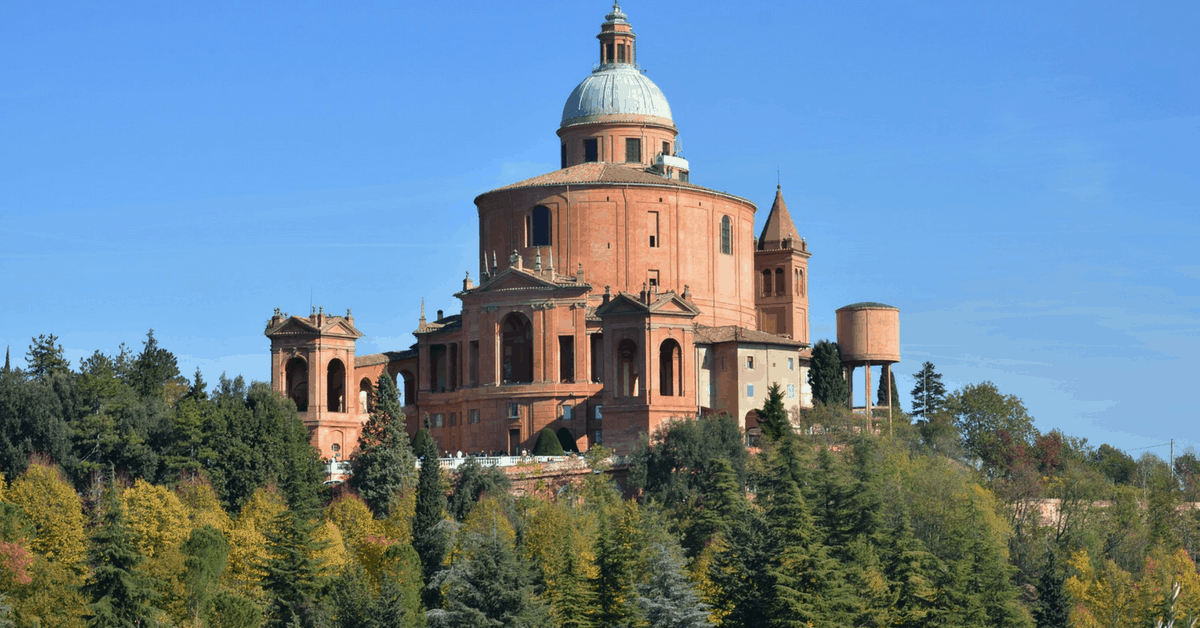Bologna is Italy’s best-kept secret. (Well, it was, until now)
In most other countries Bologna would be a famous tourist destination, but how do you compete with Rome, Venice, and Florence?
Turn aside from those well-worn tourist trails and see some authentic Italian culture. And if you are touring Italy, it will not even be out of your way.
While all roads lead to Rome, all roads lead THROUGH Bologna. Located just north of the Apennine mountains, it is on the main north-south rail and road routes.

What’s so special about Bologna?
Bologna has been nicknamed ‘la rossa, la grassa, la dotta’, or in English, “the red, the fat, the erudite”.
Firstly, she is called red because of the colors of the old town. Apart from the red roofs, many of the buildings are reddish, orange, yellow or ochre, and very attractive when seen bunched up together along the narrow streets.
Another unusual feature of the architecture is the way that the roads are lined with colonnades or porticoes. These are covered walkways formed by overhanging buildings, giving the pedestrian shady sidewalks in the summer and dry ones in the rainy winter time.
In all, there are 38 kilometers of these arcades. The longest stretch runs for three and a half kilometers from the city gates to the San Luca Sanctuary on a hill outside the town.

She is “the fat one” because of her delicious food. We are all familiar with spaghetti Bolognese which takes its name from Bologna.
Naturally, once you have eaten the genuine article you will never want to taste the insipid fare we call Bolognese again. But you’ll definitely want to try the lasagna, which also hails from Bologna, as do tortelloni and tortellini, those splendid creations of the local chefs.
When visiting Bologna, make sure you spend some time in some of the tiny pasta shops, where you can buy all manner of freshly made pasta. Not to mention the delicatessens with their salamis and hams. The meat, some call baloney, by the way, is called mortadella here, and the name of the town is pronounced “bo-lo-nya”.
And now for “erudite”. Bologna lays claim to the oldest university in the world, founded in 1088. Some of her most famous students include Dante, Petrarch, Thomas Becket, Erasmus of Rotterdam, and Copernicus. Umberto Eco, who wrote the Name of the Rose, is a professor of semiotics there.
During the Middle Ages, the wealthy burghers of Bologna competed to see who could build the tallest towers. These were constructed both for protection from feuding neighbors and as status symbols.

Although most have fallen down over the years, right in the center, two of the tallest remain standing, somewhat crookedly it has to be said, reminiscent of the Tower of Pisa. One of these can be climbed by the fit tourist and gives splendid views as a reward for the effort.
Every self-respecting Italian city has an imposing church at its heart, and Bologna is no different.
The Basilica of San Petronio dominates the main square and is the fifth largest church in the world. Another claim to fame is that the facade was never finished (the builders ran out of money), and that means the bottom half is green and white while the top unfinished brick. Inside, the most interesting feature is the longest sundial in the world.
Along the floor of the nave is a meridian line marked with the months and seasons, and in the ceiling is a tiny hole allowing a ray of light inside. This strikes the sun line with precision, indicating the time of year and culminating in the summer solstice.
These are just a few of Bologna’s sights.
In summary, Bologna is an underrated and often overlooked gem of a destination.
Why not avoid the crush of tourists in other Italian towns, and take a trip to Bologna?
Have you visited Bologna? Please tell us your favorite part. Was it the food, the scenery, or something else entirely. I’d love to hear about your visit to Bologna!
